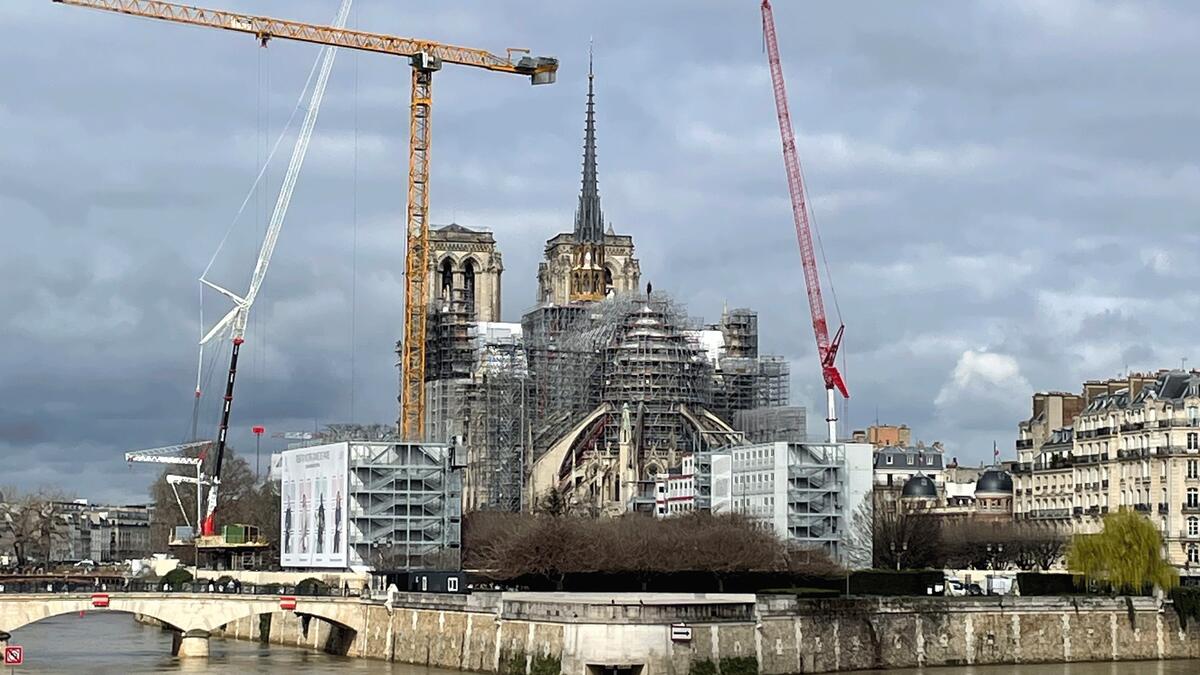Chemistry classes are key to art student's success

Restoration continues in Paris on the Notre Dame Cathedral (pictured in April 2024). A 2019 fire left the spire collapsed, the roof destroyed and some of the works of art and religious relics damaged. Specialty workers — carpenters, stone masons and artisans from dozens of disciplines — have been working to restore the structure. ASU art history major Amanda Barnette is combining her art studies with chemistry classes to learn about historic building preservation. Photo by Penny Walker/ASU News
Amanda Barnette has a passion for art preservation.
That means that, for the past four years, the Arizona State University student’s schedule was filled with classes that fit her artistic bent: art history, art renaissance, modernism, foundation drawing.
And then there were the chemistry classes — which to the untrained eye seemed to stand out in her schedule like an Andy Warhol piece in a Monet collection — classes that the art history major needed in order to pursue a career in art preservation, more specifically the preservation of historic buildings.
Chemistry matters
When most people think about college chemistry, they probably assume that the classes are filled with students pursuing science, engineering or even medical degrees — but there are many careers that require chemistry knowledge.
Winemakers, fire investigators and even farmers need to know the ins and outs of composition, structure, properties and the reactions of matter to do their jobs.
“There are not many aspects of life that chemistry does not touch,” said Ashli Morgan, assistant teaching professor in ASU’s School of Molecular Sciences.
Morgan described some “really cool fields,” like viticulture (the study of grapes, including everything from wine production to fresh table grapes), brewing, cosmetic and fragrance design, and forensics, that would be impossible to do without chemical knowledge.
Biological and medical illustrators and certain areas in the law — such as environmental and patent law — also require extensive scientific knowledge, as do science communicators, who need to translate complex chemical concepts into terms that the average person can understand.
Likewise, other areas of art — such as photography and painting — utilize chemicals in the production of works.
Crucial for art preservation and authentification
And then there are people who want to work in art preservation or, like Barnette, the historic preservation of architecture.
“Having an understanding of chemistry is essential for those interested in pursuing a career in art preservation,” said Amelia Hay, program coordinator for ASU’s Culture and Access Department at the Herberger Institute for Design and the Arts.
“Artists use an incredibly broad range of materials in their artwork. Therefore, it is important for the conservators and caretakers to know how those materials ... react to other materials and substances, and how materials change naturally over time.”
Knowing chemistry is also necessary to determine the authenticity of art or architecture. Techniques like dating and analyzing materials help experts learn where the artworks came from, when they were made, and, ultimately, if they are real or fake.
“Chemistry is critical to understanding how artist materials deteriorate,” said Dana Mossman Tepper, chief conservator at ASU Art Museum. “... And how artist materials interact with environmental factors like temperature, relative humidity, and pollutants,”
To give an example of the kind of work she's interested in, Barnette referenced the ongoing restoration efforts of the Notre Dame Cathedral in Paris, which was ravaged by fire in 2019.
“Chemistry helps to maintain these artistic and architectural treasures for future generations to enjoy,” she said.
Out of her element
It would be safe to say that Barnette was a bit out of element in her first chemistry classes.
Although the labs were fine, comprehending the theoretical aspect of the subject was difficult, she said.
“It has taken a lot of effort,” said Barnette, who originally went into cosmetology after graduating high school. “Sometimes, when I was studying, I just needed a five-minute nap and I'd be OK.”
Difficult yes — but well worth it.
In the end, it was the combination of her art history degree from ASU and her chemistry classes that helped her get accepted into the historic preservation graduate program at The School of the Art Institute of Chicago.
When she learned that she had been accepted to the school, “I cried happy tears for hours,” she said.
For others following her path, she recommends a minor in chemistry — “that way the application process for graduate school will be a smoother transition.”
The graduating student credits ASU for her success, saying the university was her “steppingstone before going to graduate school.”
“It is where I built up the basic skills to thrive,” she said.
More Arts, humanities and education

ASU alumna makes her way back to the ASU Gammage stage for '¡azúcar!'
As the Los Angeles-based CONTRA-TIEMPO dance group prepares for its upcoming production “¡azúcar!” at ASU Gammage, for one member of the dance group it is also a nostalgic return to her home.Born in…

ASU FIDM professor wins international award for fantastical, sustainable creation
The horror of an ailing Earth inspired an Arizona State University fashion professor to create a fantastical garment out of sustainable, re-used and found materials that won a prestigious…

ASU workshop trains educators, professionals from marginalized communities in disaster science
As devastating as hurricanes can be to anyone caught in their paths, they strike marginalized communities even harder.To address this issue, a fund named for a former Arizona State University…
